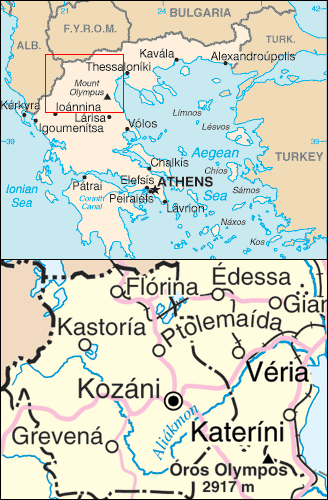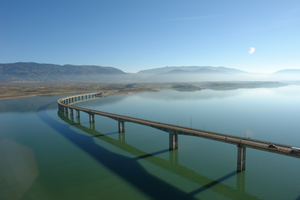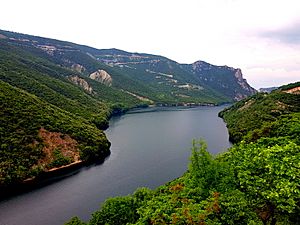Haliacmon facts for kids
Quick facts for kids Haliacmon |
|
|---|---|
 |
|
| Country | Greece |
| Physical characteristics | |
| Main source | Pindus mountains |
| River mouth | Aegean Sea 40°28′4″N 22°39′15″E / 40.46778°N 22.65417°E |
| Length | 297 km (185 mi) |
| Basin features | |
| Basin size | 8,813 km2 (3,403 sq mi) |
The Haliacmon (Greek: Αλιάκμονας, Aliákmonas) is the longest river that flows completely within Greece. It is about 297 kilometers (185 miles) long. While some other rivers are longer overall, the Haliacmon covers more distance inside Greece than any other.
The river flows through several regions in Greece. These include West Macedonia (Kastoria, Grevena, and Kozani areas) and Central Macedonia (Imathia and Pieria areas). The area of land that drains into the Haliacmon River, called its drainage basin, is about 8,813 square kilometers (3,403 square miles).
Contents
What's in a Name? The Haliacmon River
The Greek name for the river, Aliákmonas, has an interesting meaning. It comes from two ancient Greek words: alas, meaning "salt" or "sea," and akmon, meaning "anvil."
In Greek mythology, Haliacmon was one of the Potamoi. These were river gods, believed to be the sons of Oceanus and Tethys. Ancient Greeks often used these stories to explain big changes in the land, like after a great flood.
There's an old story about the Haliacmon River. It says that if sheep drank its water, their wool would turn white. The Roman writer Pliny the Elder (who lived from 23 to 79 AD) even wrote about this. He said, "In Macedonia, those who want their sheep to be white go to Haliacmon."
Other names for the river have been used throughout history. The Ottoman Turks called it Ince-Karasu, which means "narrow-black water." This name is still used in Turkey. In some Slavic languages, it's called Bistritsa.
Where Does the Haliacmon River Flow?
The Haliacmon River starts high up in the Gramos mountains in northern Greece. These mountains are close to the border with Albania.
At first, the river flows mostly towards the east. Then, it turns southeast when it gets near the city of Kastoria. It makes a big curve around the Vourinos mountains and then turns northeast near the village of Paliouria.
Important Lakes and Bridges
The Haliacmon feeds a large artificial lake called Lake Polyphytos. This lake was formed after a hydroelectric dam was built. A very long bridge, the Lake Polyfytos Bridge, crosses this lake. It is part of the main road connecting Athens and Kozani.
Southeast of Veria, the Haliacmon enters the central Macedonian plains. This area is very important for farming. Finally, the river flows into the Thermaic Gulf, which is part of the Aegean Sea. It enters the sea west of the delta of the Axios river.
Rivers Joining the Haliacmon
Many smaller rivers flow into the Haliacmon. These are called tributaries. Some of its main tributaries include Gramos, Ladopotamos, Pramoritsa, Grevenitikos, Venetikos, and Tripotamos.
The Haliacmon River passes by several towns. These include Nestorio, Argos Orestiko, Neapoli, Paliouria, Velventos, and Alexandreia.

Wildlife in the Haliacmon River Wetland
The Haliacmon River and its surrounding areas are home to many different kinds of plants and animals. This area is known as a wetland.
Fish in the River
The Haliacmon River has 33 different kinds of fish. About 30 of these fish are native to the area. Some fish, like carp and rainbow trout, show that the river's water is still clean. One type of fish, called mavrotsironi, lives nowhere else in the world! This means it is endemic to the Haliacmon.
Many of these fish are not caught for food but are very important for the food web. They help support all the other animals that live in and around the river. For people who fish for fun, rainbow trout have been added to the river. These fish do not easily reproduce in the wild, so they do not harm the river's ecosystem.
The River Delta and Sea Life
Where the Haliacmon River meets the sea, a large delta has formed. This delta covers about 4,000 hectares. A big dam on the river holds back much of the soil and sediment that the river carries. This means less new land is added to the delta. In the summer, when the river water is low, the sea can flow into the river bed.
In the Haliacmon's Delta, you can find fish like Flathead mullets and European seabasses. The shallow parts of the sea here are important places for young fish from the Aegean Sea to grow. Also, about 90% of Greece's mussels are grown in the Haliacmon-Axios (Vardar) Delta. There is also an area called Aliki Kitrous, where 15,000 to 20,000 tons of salt are made each year.
Birds of the Haliacmon
Many kinds of birds visit the Haliacmon region. Some birds, like ducks, stay there for the winter. Others use it as a resting spot during their long journeys when they migrate.
About 215 different kinds of birds have been seen here. Around one-third of these birds build their nests in the area. More than 10% of the birds found here are endangered. This includes the Dalmatian pelican and the curlew, which are some of the rarest birds in the world. Twenty-seven kinds of rare and protected birds nest in the region, such as the purple heron.
Haliacmon River in History
In ancient times, the mountains where the Haliacmon starts were called the Canalovii by Claudius Ptolemy. According to Julius Caesar, the Haliacmon River was the border between Macedon and Thessaly.
The river flowed through a region called Elimiotis, giving it water. Then, it formed the border between Pieria, Eordaea, and Imathia. In the time of Herodotus, the Haliacmon was thought to join another river called the Loudias. However, the Loudias river changed its path and now flows directly into the Aegean Sea.
The Haliacmon River was also linked to a river god named Haliacmon in ancient Greek stories.
Images for kids






